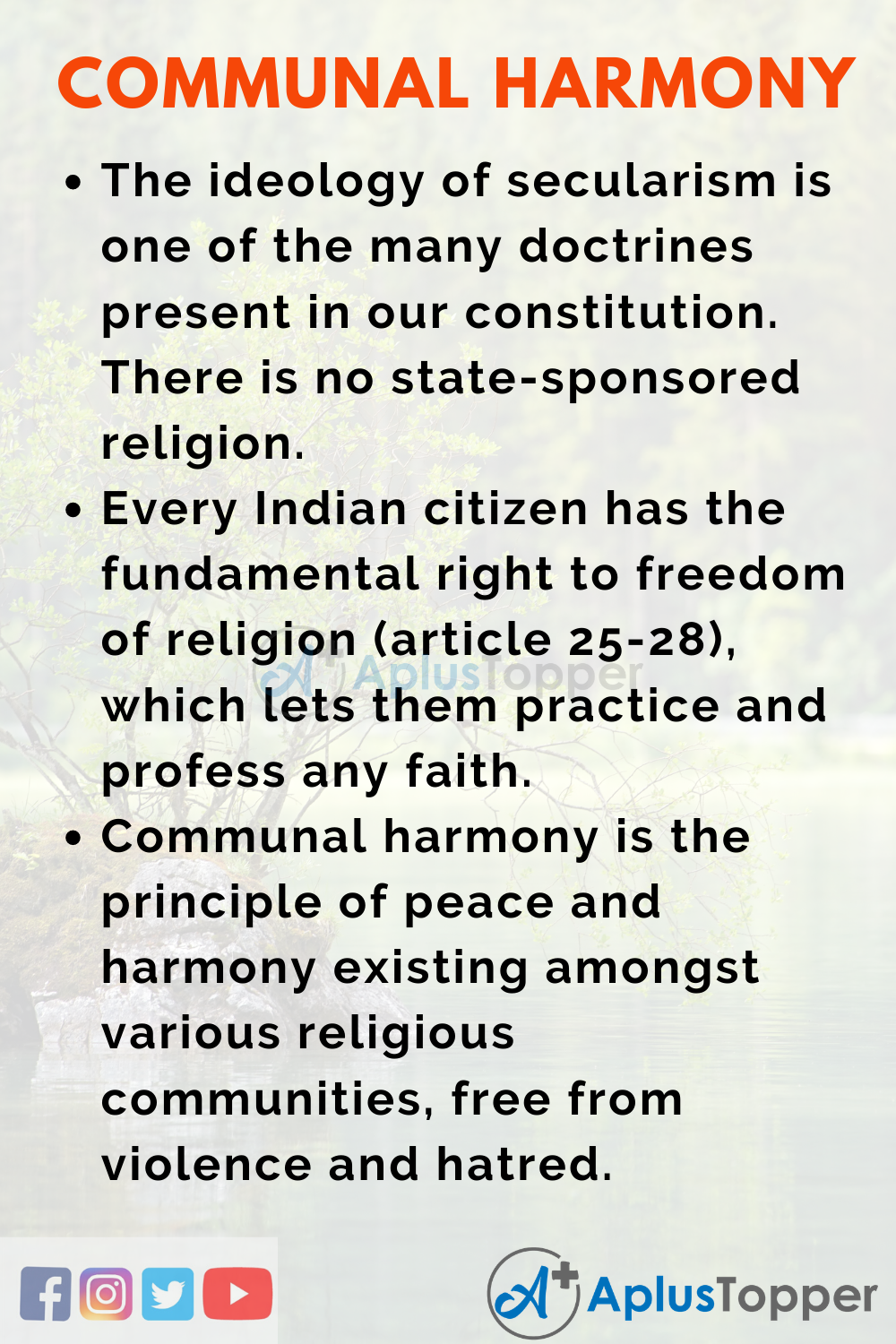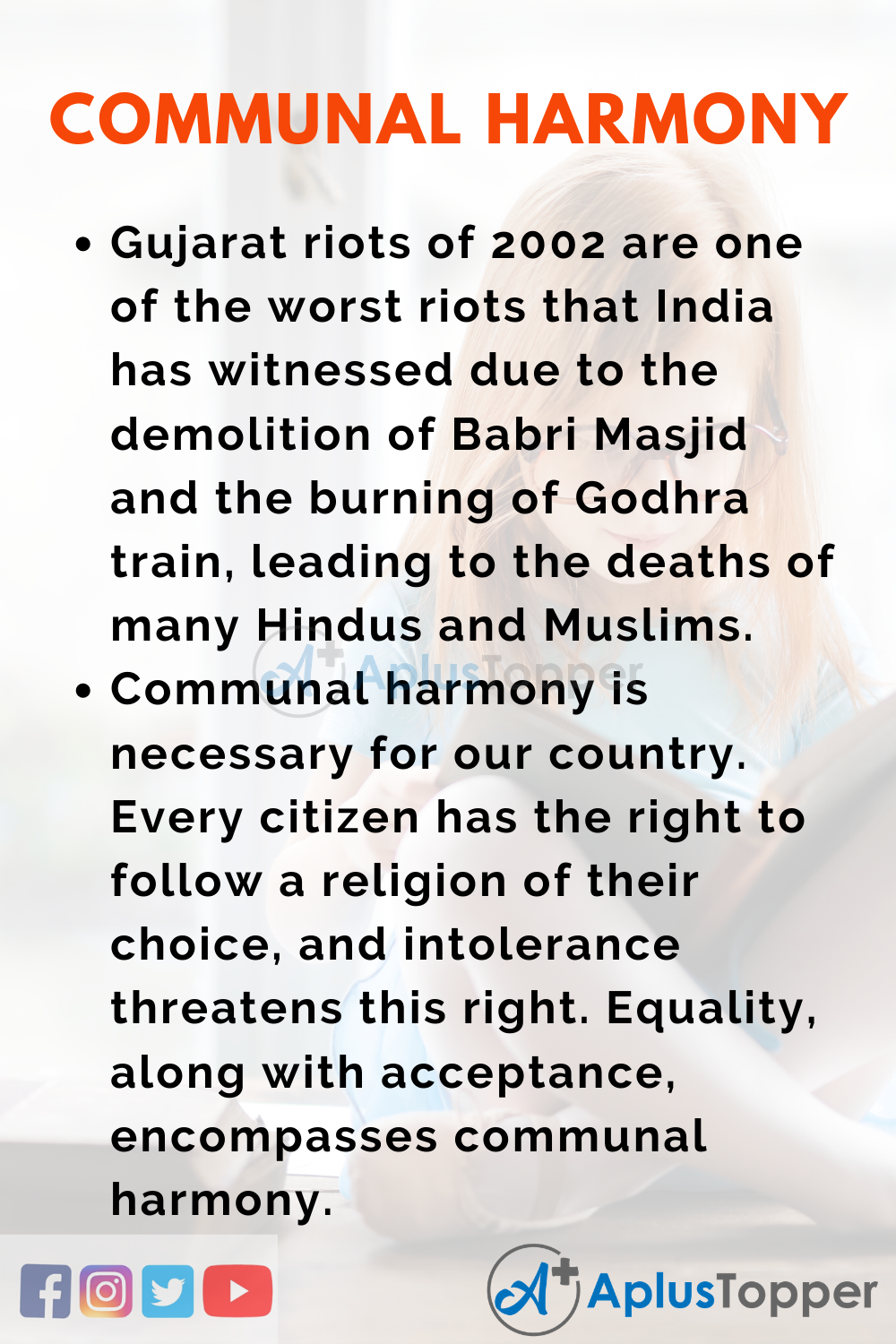Essay on Communal Harmony: Secularism is one of the many imbibed ideologies in the Indian constitution. The word secularism is in the preamble as well. India does not advocate state-sponsored religion, nor does it have a national religion of any sort. India is home to citizens who have different religious affiliations. The principle of secularism allows them to practice and preach their religion.
However, communal riots in India occur due to differences between religious communities. These turn incredibly violent and gruesome. Communal harmony is a prerequisite for a country like India, with its diverse population and cultures. Communal harmony ensures that every religion gets equal treatment, and tolerance builds amongst citizens.
You can read more Essay Writing about articles, events, people, sports, technology many more.
Long and Short Essays on Communal Harmony for Students and Kids in English
Below we have provided one long essay on Communal Harmony of 400-500 words and one short essay on Communal Harmony of 200 words.
Long Essay On Communal Harmony 500 Words in English
The long essay on communal harmony is suitable for students of Classes 7, 8, 9, 10, and competitive exam aspirants.
The ideology of secularism is one of the many doctrines present in our constitution. India does not have a state-sponsored religion. Every citizen must equally be treated, and the state must now favor any one religion. One of the fundamental rights guaranteed is the right to freedom of religion, article 25-28. Citizens can practice and profess their faith. Communal harmony is the principle of peace and harmony existing amongst various religious communities, free from violence and hatred. It involves toleration and respect for each other’s belief such that non-violence prevails.
Maintenance of communal harmony hasn’t been easy for India. These instances require intervention and strict action. India has experienced communal disharmony, which causes intolerance and riots against communities. Some incidents of communal disharmony:
- Bharuch riots: These riots occurred after the 1857 rebellion, when Bejonji Sheriaiji Bharucha, a Parsi, was held for insulting a Mosque that ignited riots. During this time, Sheriaiji was lynched, a prominent fire temple Dastur Kamdin Dar-e Mihr burnt down, and the high priest killed.
- Anti – Sikh riots: These riots broke out after the assassination of former prime minister Indira Gandhi, killed by her two bodyguards who were Sikhs on 31st October 1984. Her murder was a response to Operation Blue star, which damaged the holy Golden Temple, hurting Sikh sentiments. The riots witnessed more than 3,000 Sikhs in Delhi killed and over hundreds outside the capital.
- Bombay riots: The Babri Masjid demolition has also been a contentious and sensitive issue in India. The Bombay riots were a response to the destruction by the Hindu Karsevaks of 1992; Muslims protested against this demolition. The riots took place in December 1992 up till January 1993; nearly 900 killed. The Bombay bombings were a response to the riots.
- Gujarat riots: The Gujarat riots are one of the worst riots that India has witnessed, which damaged communal harmony in India. The disturbances arose in Ahmedabad in 2002. The riots were resultant of the demolition of the Babri Masjid and the burning of the Godhra train, which led to the deaths of many Hindus and Muslims; more than a thousand people killed and 2500 injured. The riots saw fatalities from both communities.
- Muzaffarnagar riots: One of the worst riots of Uttar Pradesh, the Muzaffarnagar riots saw a clash between the Hindu Jats and Muslims between August and September of 2013 with nearly 62 people killed, and more than 50,000 displaced. The cause for these riots was a part of many instances between the communities that escalated tensions between them.
These are just a few of the many instances of violence between religious communities, with the most recent Delhi riots, which escalated due to the Citizenship (Amendment) Act of 2019. Communal harmony is necessary for our country. Every citizen has the right to follow a religion of their choice, and intolerance threatens this right. Equality is an essential aspect of communal harmony, along with acceptance. Peace can exist between communities once the importance of communal harmony is understood. Communal harmony day or Sadhbhavana Diwas celebrates this idea on 20th August of every year in India.

Short Essay On Communal Harmony 200 Words in English for Kids
Essay on Communal Harmony essay is suitable for students of Classes 1, 2, 3, 4, 5, and 6.
Communal harmony exists when there are peace and harmony among different religious communities. India is a diverse country, is home to many religions. The constitution of India mentions that India is a secular country meaning that its people can practice and profess the faith of their liking. All citizens can follow any religion they want, and the state cannot support or favor any one religion. The constitution also provides us with a fundamental right to freedom of religion. All Indians have fundamental rights that they have since birth.
However, communal disharmony treats peace and harmony among religions, causing riots. These riots turn violent, killing, and injuring many people of different religious communities. Many have to leave their homes due to these riots. Some instances of communal riots include the Bombay riots of 1993, Gujarat riots of 2002, the Muzaffarnagar riots of 2013, and the Delhi riots of 2020.
These riots show us the importance of communal harmony for a country such as India. We need to respect another person’s religion and faith. The constitution provides for laws and protection of citizens. The government takes strict action during these riots. The importance of communal harmony should be spread and made aware of all. The right to freedom of religion protects us, but at the same time, we must build tolerance and respect towards different faiths. Communal harmony day or Sadhbhavana Diwas celebrates this idea on 20th August of every year.
10 Lines on Communal Harmony Essay in English
These ten lines are helpful for competitive exam aspirants and making speeches.
- The ideology of secularism is one of the many doctrines present in our constitution. There is no state-sponsored religion.
- Every Indian citizen has the fundamental right to freedom of religion (article 25-28), which lets them practice and profess any faith.
- Communal harmony is the principle of peace and harmony existing amongst various religious communities, free from violence and hatred.
- India has witnessed many instances of communal disharmony throughout its history.
- Some include Bharuch riots of 1857 between Muslims and Parsis and the anti-Sikh riots directed at the Sikh community in 1984.
- The Bombay riots of 1992-93 were a response to the demolition of the Babri Masjid, a very contentious issue in India, with nearly 900 killed. After these riots, the Bombay bombings took place.
- Gujarat riots of 2002 are one of the worst riots that India has witnessed due to the demolition of Babri Masjid and the burning of Godhra train, leading to the deaths of many Hindus and Muslims.
- The recent communal riots in India were the Muzaffarnagar riots of 2013 and the Delhi riots of 2020.
- Communal harmony is necessary for our country. Every citizen has the right to follow a religion of their choice, and intolerance threatens this right. Equality, along with acceptance, encompasses communal harmony.
- Communal harmony day or Sadhbhavana Diwas celebrates this idea on 20th August of every year in India.

FAQ’s On Essay on Communal Harmony
Question 1.
What is the meaning of communal harmony?
Answer:
Communal harmony is the principle of peace and harmony existing amongst various religious communities, free from violence and hatred.
Question 2.
What is the provision in the constitution regarding religion?
Answer:
Every Indian citizen has the fundamental right of freedom of religion (article 25- which lets them practice and profess any religion.
Question 3.
What are some instances of communal disharmony?
Answer:
Some of the instances of communal disharmony include Some cases of communal riots include the Bombay riots of 1993, Gujarat riots of 2002, the Muzaffarnagar riots of 2013, and the Delhi riots of 2020.
Question 4.
When does India commemorate Communal Harmony Day?
Answer:
India commemorates Communal Harmony Day or Sadhbhavana Diwas on 20th August of every year.
